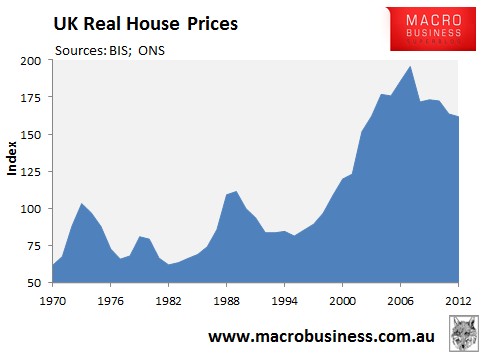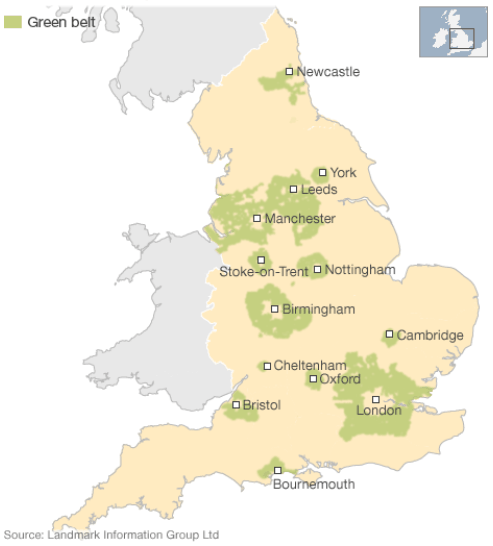
In Monday’s PowerPoint Presentation on Housing supply & price volatility, I included a chart showing the extreme price volatility of housing in the UK, where prices have experienced four boom and bust cycles since 1970. (see next chart).

As noted previously, tight planning restrictions have been in place in the UK since the passage of the Town and Country Planning Act 1947, which established that planning permission was required for land development and that ownership alone no longer conferred the right to develop the land.
The passage of this Act also saw the establishment of greenbelts around UK cities, which excluded large swathes of agricultural land from urban development (see below graphic).

In the 1990s, the Central Government tightened land supply even further by explicitly requiring that 60% of all new land for housing must be brownfield land – i.e. land which has already been developed for some other purpose.
A final related roadblock to housing supply in the UK is its centralised fiscal system, whereby local authorities – which are the primary decision makers on development and have statutory obligations to provide services for new houses – receive very little revenue from increased population and housing. As such, these local authorities tend to be biased against development.
Combined, these regulatory constraints on new housing construction have meant that housing supply in the UK has been incapable of responding quickly and efficiently to changes in demand, thus placing upward pressure on prices and creating expectations of future capital growth.
This view received strong support in a recent study by the London School of Economics (LSE) Spatial Economics Research Centre (SERC), which attempted to quantify the role that the planning system plays in driving-up housing prices in the UK, as well as price volatility, by examining 35 English Local Planning Authorities (LPAs) using 35-years of data.
The key extracts from the study are as follows:
A new-build house is 38 percent smaller in the UK than in densely populated Germany and 40 percent smaller than in the even more densely populated Netherlands…
Real house prices – but not real incomes – have grown faster in the UK over the last 40 years than in any other OECD country. As a consequence of this, a genuine ‘housing affordability crisis’ has been developing. Young households are particularly strongly affected; they increasingly struggle to get their feet on the owner-occupied housing ladder…Price volatility is similarly extraordinary. During the last full real estate cycle real house values in the UK as a whole first rose by 83 percent during the upswing of the 1980s; they subsequently declined by 38 percent during the downturn of the first half of the 1990s. This swing is substantially larger than that of the most volatile metro area in the US during the same cycle period: real values in Los Angeles rose by 67 percent and declined by 33 percent…The proposition that the English planning system impacts house prices is not far-fetched. The planning system is widely viewed as inflexible. Historically, it ignored market signals and has failed adequately to cope with changing socio-economic conditions. This rigid supply regime has been suggested – but not tested – to be an important cause of England’s excessively high level and volatility of house prices…According to our baseline estimate, house prices would be around 35 percent lower if, hypothetically, all regulatory constraints were removed. More pragmatically: had the South East, the most regulated English region, the regulatory restrictiveness of the North East, still highly regulated in an international context, house prices in the South East would be roughly 25 percent lower. The effect of constraints due to local scarcity of developable land is largely confined to highly urbanised areas. The local impact of uneven topography is quantitatively less important. Hypothetically removing both types of physical supply constraints, again according to our baseline estimate, would reduce house prices by 15 percent.We also find that the effects of the various supply constraints on the price earnings elasticity are greater during boom than bust periods. The year fixed effects in our estimates imply cyclical behaviour also at the aggregate level. However, most of the cyclicality can be explained by local demand fluctuations in conjunction with local supply constraints…An increase in house price volatility, through the consumption channel, also has important negative consequences for the macro-economy. A higher degree of house price volatility may lead to increased volatility of consumption and reduced macro-economic stability. It was these types of considerations that lead the UK government to scrutinise the planning system and its relationship with the wider economy in the first instance.
The Impact of Supply Constraints on House Prices in England (SERC Sept 2012) by leithvanonselen

